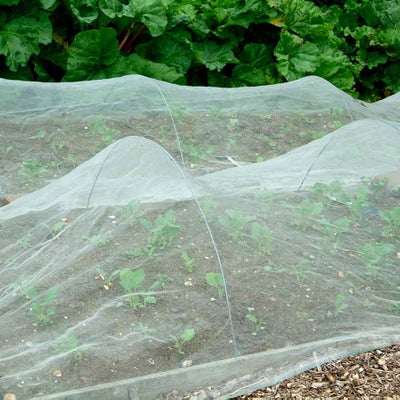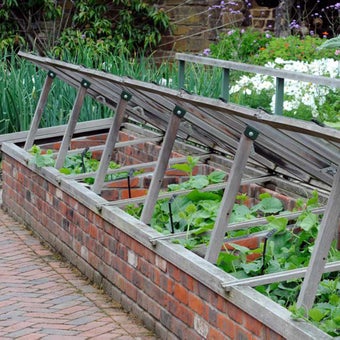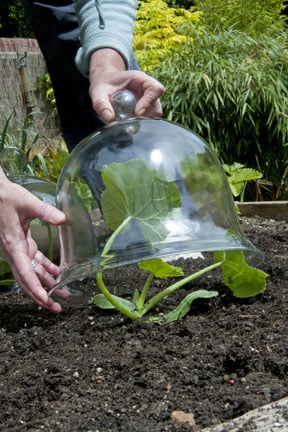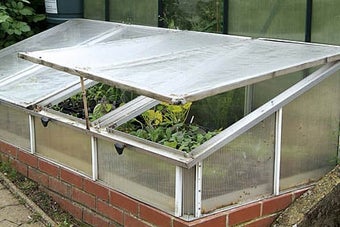
Quick facts
Re-use old plastic-based fleeces, or if new fleece is needed, choose plastic-free options
Crop covers speed up growth in spring
Heavier grades of fleece give some frost protection
Crop covers give good protection from pests such as leek moth and cabbage caterpillars
Crop covers are very light so need no supporting hoops
What are fleece and crop covers?
and crop covers are translucent or transparent sheets that are laid over or around plants to hasten their growth and protect them against weather and pests. These materials can be bought cut to length in packs, or are sometimes sold by the metre cut from a roll. There are several options available:
Fleece – all types of fleece are extremely lightweight and have good insulation properties. It’s best to re-use fleece if you have it, or else purchase plastic-free options.
- Plastic-free options include fleece made from plant-based materials and sheep’s wool
- Polypropylene ‘fleece’, sometimes referred to as horticultural fleece, is a non-woven plastic-based material
Lightweight fleece gives less protection but better light penetration than the heavy-duty fleece that can be used to protect tender plants.
Crop covers are thin, light, transparent polythene sheets (can be perforated or woven to allow excess heat and to escape). They offer protection against wind and hail, and can break the impact of heavy rain and protect the soil from mechanical damage, but have issues with over-heating and lack of insulation at night.
- Plastic-free or options are starting to become available
- Different grades of crop cover give different levels of warmth and protection
Since they are very light, both fleece and crop covers can be laid directly over the crops and need no supporting hoops.
Why are fleece and other crop covers used for?
and crop covers can be used in gardens to cover plants. These materials provide a small but significant amount of protection from cold or windy weather, and can be used to exclude some pests.
Fleece is white, extremely light, soft and warm to the touch. For this reason it is often used to wrap slightly tender plants against winter weather. Its porosity makes it much less prone to over-heating and wet conditions than polythene covers.
Crop covers play a similar role to cloches but can cover a large area and are easy to store. They can be laid over plants to encourage faster growth, particularly in spring, and earlier crops.
Advantages
Raising temperatures
Crop covers work by warmth from the sun raising temperatures by a few degrees, typically 2°C, compared to uncovered plants. This can advance maturity or flowering by about two weeks.
Spring: Covered tender plants can be sown or planted out earlier than if uncovered by about two weeks in spring. Crucially crop covers prevent overheating by allowing heat to escape through holes built into them during manufacture. Unpierced transparent polythene sheeting or bubblewrap, for example, would not only lead to excess moisture but damage plants by excess heat on sunny days even in mid-spring.
Late summer and autumn: In late summer and autumn crop covers can allow tender crops such as cucumbers and bush tomatoes to ripen. Autumn sowings can be protected over winter to allow earlier crops than spring sowing; carrots and chard for example.
Winter: is often used to insulate plants against winter cold. In fact without heat from the sun (solar gain) the temperature around covered plants will fall quite quickly to the ambient temperature. However, fleece does protect from other aspects of harsh weather – wind and hail, for example – and is often used in conjunction with straw and similar materials where the combined effect of fleece and insulation is very effective.
Different grades of fleece give different levels of cold protection; light fleece (17g per sq m) for instance, gives less protection but better light penetration (and is cheaper) than heavy duty fleece (35g per sq m). The latter might be used to protect tender plants and the former to advance young crops of .
Wind protection
Wind often retards growth of plants in British gardens as much as temperature. Crop covers, if well anchored, enhance growth rates by avoiding stress from wind (mechanical stress and water loss).
Hail
Crop covers offer some protection against the small hailstones generally encountered in Britain.
Managing difficult soils
Crop covers break the impact of heavy rain and protect the soil to some extent from mechanical damage that can lead to significant surface compaction limiting seed emergence and growth of young plants.
Pest and disease protection
Used as a physical barrier, unperforated crop covers can be highly effective in excluding pests. Insect-proof meshes are a variant of crop covers that give protection against insects often without significant increases in temperature but good protection against wind and hail.
Disadvantages
Pollination problems
Insect-pollinated crops such as strawberries and courgettes are unsuited to growing under crop covers during their flowering period.
Sustainability
made from polypropylene and crop covers made from polythene have a useful but short life and councils don’t currently offer recycling to home gardeners for these products. Choosing eco-friendly protective coverings made from natural and materials is a better option. Bear in mind that covers cut to specific/small sizes may not be so easy to re-use.
Product choice
: Both plastic-free options and polypropylene fleece can be used for tunnel cloches and floating films. These trap warmth, allow rain through and, being porous, allow excess heat and to escape.
They are especially useful for covering seeds, transplants and rooted cuttings. Fleece-covered crops can be harvested two weeks ahead of crops in the open. Unlike polythene, fleece can be left on all summer (to exclude pests, for example). Fleece can also be double-layered for extra frost protection, and can be used beneath glass or plastic cloches and in cold frames and greenhouses for extra insulation.
- Plastic-free options,such as sheep’s wool or BioFleece made from plant materials, are the most sustainable choices. They do handle differently to traditional fleece, the sheep’s wool being a heavier material, but still do the same job.
- Polypropylene fleece is not durable, especially the 17g fleece, which may only last a year and quickly break down into small pieces. It is also is vulnerable to fox damage.
Woven meshes: Woven polythene covers such as Envirotect are durable – lasting at least five years – and resist foxes to a considerable extent. It can be rinsed to clean it. It is made of very soft polythene and claims to have similar properties to 17g fleece.
Perforated or ‘ ’ polythene: Clear polythene with numerous holes cut into the sheet were the first crop cover that provided pest protection. Temperatures and humidity can also rise to damaging levels from late spring, but on the other hand they capture more warmth and prompt more growth in early to mid-spring. This is plastic-based, so if you can use cloches instead, these are a more sustainable choice.








